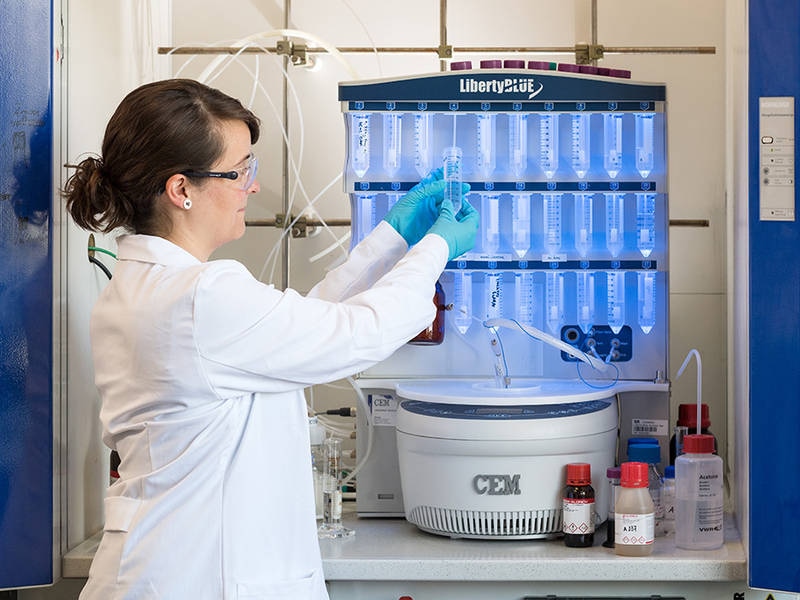Jul 20 2017
Materials capable of assembling themselves and then just disappearing toward the end of their lifetime are relatively common in nature. Recently, Researchers at the Technical University Munich (TUM) developed supramolecular materials that have the potential to disintegrate at a predetermined time. This feature can be used in a number of applications.
 With the peptide-synthesizer Dr. Marta Tena-Solsona produces the building blocks for the gels she investigates. (Photo: Uli Benz / TUM)
With the peptide-synthesizer Dr. Marta Tena-Solsona produces the building blocks for the gels she investigates. (Photo: Uli Benz / TUM)
Worn-out mobile phones, torn T-shirts, old toys, empty cans and plastic bottles – day by day, mankind produces waste amounting to millions of tons. How can the planet be prevented from stifling in the garbage?
To this day, recycling is considered to be the method of choice. But it is expensive.
So far, most man-made substances are chemically very stable: to decompose them back into their components, one has to spend a lot of energy. Nature does not produce garbage dumps. Instead, biological cells are constantly synthesizing new molecules from recycled ones. Some of these molecules assemble into larger structures, so-called supramolecular assemblies that form the structural components of the cell. This dynamic ensemble inspired us to develop materials that dispose of themselves when they are no longer needed.
Job Boekhoven, Professor of Supramolecular Chemistry at the TUM
Nature as a Model
A main difference between most living biological materials and man-made substances refers to their management: man-made materials are in balance with their environment. This explains the fact that they do not exchange energy and molecules, thus staying the way they are.
Nature functions based on another principle: Living biological materials, such as bone and skin and also cells, are not in balance with their environment. Their repair, maintenance and construction will need a steady input of building blocks and energy.
A typical example of an energy source is adenosine triphosphate, ATP for short. As long as enough energy is available, damaged components and entire cells can be broken down and replaced by new ones, otherwise the organism dies and disintegrates into its basic building blocks.
Job Boekhoven, Professor of Supramolecular Chemistry at the TUM
In the End There is Just Molecular Dust
The new materials explored by Boekhoven along with an interdisciplinary team of Engineers, Physicists and Chemists at the TU Munich are based on the natural model: originally, the molecular building blocks are freely mobile, but supramolecular structures develop if energy is added in the form of high-energy molecules.
After the energy is exhausted, they autonomously disintegrate. The lifetime can thus be predefined by the volume of “fuel” added. It is possible to set the materials to autonomously degrade after several minutes to several hours in the laboratory. Additionally, by following a cycle, the degraded material can be used again with the addition of another batch of high-energy molecules.
From Lab to Practice
The Scientists designed a variety of anhydrides which gather into inks, supramolecular hydrogels or colloids. In these materials, a chemical reaction network transforms dicarboxylates into metastable anhydrides driven by the irreversible consumption of carbodiimide as “fuel“. The metastable character of the anhydrides allows them to hydrolyze to their original dicarboxylates with half-lives ranging from seconds to several minutes.
A number of application possibilities develop since the molecules produce extremely different structures based on their chemical composition. For example, spherical colloids can be loaded with water-insoluble molecules. These molecules can be used for transporting drugs against cancer directly to the tumor cell. This mission will result in colloids autonomously dissolving, thus discharging the drugs locally.
Several other blocks gather into long fibrous structures that convert fluids into gels and can also be used for stabilizing freshly transplanted tissue for a predefined time, after which this function will be taken over by the body. It could also be possible to produce inks with precisely defined durability from molecules that gather into star-shaped assemblies.
Will it be possible to manufacture mobile phones or supramolecular machines that just disappear when they are no longer required?
This might not be completely impossible, but there is still a long way to go. Right now we are working on the basics.
Job Boekhoven, Professor of Supramolecular Chemistry at the TUM
The research was funded by the German Research Foundation (DFG) through the ATUMS Graduate Program (Alberta/TUM International Graduate School for Functional Hybrid Materials), the Collaborative Research Centre SFB 863 (Forces in Biomolecular Systems) and the Cluster of Excellence Nanosystems Initiative Munich (NIM), as well as the TUM Institute for Advanced Study which is funded by the German Excellence Initiative and the European Union Seventh Framework Program.